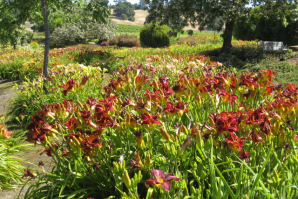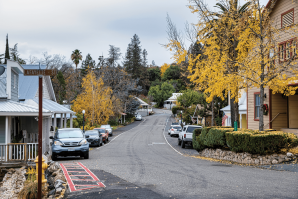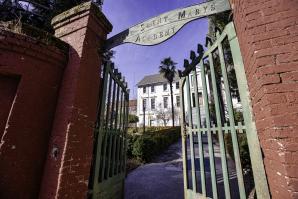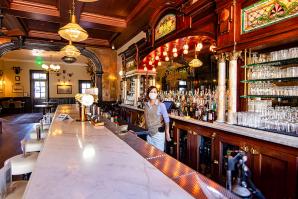Maybe it starts with a fourth-grader’s California history report, with pages of a textbook brought to life by a short road trip to learn about Native American tribes, the Gold Rush and the Transcontinental Railroad. Or perhaps it’s a grownups-only jaunt to a quaint Main Street, where 19th century buildings now house espresso counters, boutiques filled with unique clothes and delicate art objects, and wine bars pouring generous flights.
For many reasons, visitors flock to the state’s historic districts, contributing to a tourism economy that grew by 32 percent in 2022. “Northern California’s historic towns offer treasures unique from other destinations in California,” says Visit California president and CEO Caroline Beteta, who notes that statewide travel-related spending reached $134.4 billion in 2022. “The combination of vintage charm, historic architecture and a relaxed way of life transports visitors, offering an authentic glimpse to life in the Old West, while also showcasing modern day charm with locally owned boutiques and eateries.”
As summer sets in, we explore historic districts in five communities within driving distance of Sacramento and provide potential visitors a few highlights.
Auburn
A trip back to the Gold Rush
Gold was discovered 6 miles from Auburn, which was established in 1849 near the Middle and North Forks of the American River. Auburn’s historic district includes Old Town, with its landmark courthouse; downtown, with restaurants, shops and galleries; and Central Square, the community hub with sculptures and memorial sidewalk tiles. “Even as Auburn celebrates its historic past,” says Visit Placer CEO Robert Haswell, “it’s also a very hip place, full of creatives, with an art scene that has exploded.”
Auburn’s many trails offer vistas of the American River
Confluence and dam. (Photo courtesy of Visit Placer)

Central Square Art Park is one example, with its mosaic river, mural, community piano and, during recent summers, a brilliant shade canopy of umbrellas. Farther along Lincoln Way, Martin Mattox Mercantile carries a stylish collection of men’s and women’s clothing and accessories. The dog-friendly patio at The Station Public House — near the transcontinental railroad station and Gold Rush Museum — is a convivial spot, thanks to pub grub and a lengthy beer list. Back toward Old Town, lucky visitors might nab a table at Restaurant Josephine, a farm-to-table French bistro.
Haswell points out Auburn’s advantage: its accessibility. “Old Town is right off (Interstate 80), and very visible,” he says, “with one of the grandest, still-active courthouses.” Inside that building, visitors can witness current daily business and explore Placer County Museum, with its Native American artifacts and giant gold nugget. Within walking distance: the old firehouse with a candy-striped witch hat bell tower, Auburn Old Town Gallery in the Empire Livery Stable building and Auburn Alehouse in the 1856 American Block. On tap nearby at The Pour Choice: coffee, craft beer and kombucha.
Visitors can also hike, bike and run in the gold bearing hills. The Auburn State Recreation Area contains some 40 miles of trails surrounding the American River confluence for hikers, mountain bikers, equestrians and runners, including participants in the famous 100-mile Western States and The Canyons endurance runs.
Benicia
California’s bayside former capital
With views of Carquinez Strait, the Solano County city of Benicia has a rich military history as home to an arsenal that supplied weapons to U.S. troops starting in 1849. It also was the third of California’s state capitals (1853-1854), before Sacramento.
Benicia Capitol State Historic Park’s original brick building, carriage house, gardens and Fischer-Hanlon House are open for tours just off Downtown Historic District’s First Street. Shops and restaurants line First Street — which earned Benicia status as one of 20 cities in California’s Main Street Program — nearly all the way to the fishing pier. One House Bakery, with a vine-draped backyard patio, has a menu loaded with breads and pastries made from house-milled flour.
This Solano County town has a rich history, as well as charming
places to visit, including the vine-draped patio of One House
Bakery. (Photo by Stephen Austin Welch)

Benicia’s commitment to art shows up in numerous galleries and public artworks — for example, “Neptune’s Daughter,” by Lisa Reinertson, and “Light Harp,” by Scott Zoog, sit along the waterfront trail behind The Tannery Building (where leather was tanned in the late 1800s and early 1900s). Today, The Tannery houses several boutiques, The Little Art Shop (showing local artists’ works) and Cullen’s Tannery Pub, a favorite spot for whiskey. Patrons can order a loaded hot dog for just $5.75 from Char’s next door.
The Museum of History Benicia’s Downtown Gallery, on Second Street, details area history from 1900 through World War I, World War II and beyond. Two miles away in the Historic Arsenal District, the museum’s Arsenal Gallery complex comprises four 1850s sandstone buildings that housed the munitions, then later the Army’s Camel Corps — a short-term experiment using dromedaries as military pack animals. Today the site showcases Benicia’s fire collection, military memorabilia and artifacts from the area’s Native American settlers and the Gold Rush era.
Benicia has a commitment to art, with The Little Art Shop that
features local artists. (Photo courtesy of Visit Benicia)

A nice place to spend the night is the six-suite Shorelight Inn, a rejuvenated historic property just off First Street, overlooking the waterfront.
Folsom
A Victorian gem on the lakefront
The city of Folsom’s Historic District, established circa 1849, sits adjacent to Lake Natoma, the wide, sun-dappled expanse of the American River bookended by Folsom and Nimbus dams — and popular with kayakers and paddlers. The American River bike trail rings the lake, bringing cyclists and runners into town to fuel up.
Sutter Street anchors the district, which teems with antique stores, boutiques, eateries and bars. At Folsom History Museum, the Wells Fargo assay office (the Pony Express’s western terminus) runs rotating exhibits. Regular displays tell stories of the Nisenan (the area’s first inhabitants) and the Gold Rush heyday. In The Square, visitors can practice gold panning, blacksmithing, weaving and pyrography (wood-burning art) on weekend afternoons.
Folsom Hotel, established in 1885, is right in the heart of the
historic district and serves barbecue, craft beers and cocktails
along with live music. (Photo by Steve Heard)

Some landmarks include Folsom Powerhouse, circa 1895, site of California’s first hydro-electric generator; the truss bridge, built in 1893 and now open to pedestrians and cyclists; and the Historic Railroad Turntable and Public Plaza, where a popular farmers market happens on Saturday mornings and summer concerts on Thursday nights. “The charm of this district is magnified by the residents who cherish this area and continue to visit it,” says Judy Collinsworth, executive director of Folsom Historic District Association. Some 336,000 visitors come to Folsom’s Historic District each year, according to data shared by Choose Folsom.
Highlights for visitors to Sutter Street include the market-lighted patio at Scott’s Seafood Roundhouse, Willamette Wineworks’ blend-your-own workshops, barbecue at J. Wild’s, Folsom swag at Ruby’s Books (named for the white-nosed golden retriever often on site), Snooks Candies & Chocolate Factory (peanut brittle!) and two bakeries — Karen’s, with its fully stocked pastry cabinet, and Faria, with fragrant, naturally leavened breads. Dorothea’s Shoppe is famous for its year-round abundance of holiday ornaments.
Snooks Candies and Chocolate Factory has been a family-owned
candy store for more than 50 years, where visitors can watch
their famous peanut brittle being made. (Photo by Menka Belgal
Photography)

Lake Natoma Inn, which backs up to the American River Parkway, is an ideal distance from Sutter Street’s hopping nightlife — close enough to walk, far enough for quiet. For an espresso in the morning: Sociology Coffee Bar.
Lodi
A wine region on the rise
An agrarian San Joaquin County town rich with wine-making history, Lodi started as a railroad stop in 1869. By the late 1800s, the mighty grape grew in the flats where mineral-heavy soil, hot daytime sun and evening Delta breezes stressed the fruit into a prime ingredient. Today, some 90,000 acres of vineyards grace the region, and Lodi-Woodbridge growers annually produce crops worth more than $350 million. Thick, black, craggy vines lead to dark Old Vine zinfandels, a Lodi specialty — perfect for toasting the region’s history.
A striking Mission Revival-style arch welcomes visitors to Lodi,
where you can visit historic wineries dating back to the 1800s
and eat and shop along School Street. (Photo courtesy of Visit
Lodi)

Lodi’s main historic drag is School Street (and its side streets), which is crowded with wine-tasting rooms, boutiques, galleries and restaurants. The landmark Mission Arch over E. Pine Street was built in 1907 as the official entrance to the Tokay Carnival, the first Lodi Grape Festival, and symbolized Lodi’s agricultural and commercial growth. Atop the arch, the California Bear, added in 1910, faces north toward Sacramento.
Worth a stop: World of Wonders Science Museum (bring the kids!) and Tom’s Used Books (at least 35,000). Oxford Kitchen dishes up meals inspired by London, including English-style fish and chips. The Dancing Fox restaurant, brewery and winery operates in a century-old, vine-covered brick building.
Cafes spill out onto the wide promenade. (Photo courtesy of Visit
Lodi)

Also, proof that Lodi’s not all wine: Scotto’s has cider tasting, and several brewpubs pour a rotation of beers. French at Heart Home and Garden sells all kinds of French-inspired merch, and Tony Segale’s Double Dip Gallery combines art and 25 flavors of Gunther’s ice cream. Cheese Central carries 80-plus cheeses (samplers welcome). Finally, just outside downtown, in a former Texaco station on W. Lockeford Street, Guantonios makes wood-fired pizzas with organic flour, Cortopassi tomatoes (from Modesto), local Calivirgin Olive Oil and produce from area farms.
Make a weekend of it at Wine & Roses hotel, complete with a spa and restaurant (Towne House) — everything essential for a weekend wine getaway. It sits adjacent to Lodi’s Wine & Visitor Center and demonstration vineyard.
Truckee
A mountain town rich with stories
It sounds merely transportational — Truckee — but the town’s name comes from “tro-kay,” a word repeatedly uttered by a Paiute guide who helped pioneers cross the perilous Great Basin of Nevada in the mid-1800s. It meant “everything is alright.” History reveals that everything was not always alright. Truckee, elevation 5,817 feet, is infamous for the grim fate of the snowbound Donner Party in 1846-47 and the deaths of approximately 1,200 Chinese laborers who worked on the Donner Pass Summit Tunnels for the Transcontinental Railroad 20 years later.
Come smell the fresh mountain air in Truckee, where you can hike,
golf, river raft and stay the night. Rock Cellar Records offers
music for vinyl lovers while Bespoke & Atelier features a
colorful yarn shop. (Photo by Krista Minard)

But today it’s a haven for travelers on I-80, a pretty little Nevada County town tucked into the Sierra Nevada. During the summer, hikers, mountain bikers, golfers, river rafters, second-home owners and others stop on their way to and from nearby Donner Lake and Lake Tahoe. A study performed by Dean Runyan Associates, published in September 2023, totaled Truckee visitor spending in 2022 at $252 million.
Historic downtown Truckee runs parallel to the railroad tracks and the Truckee River, on Donner Pass Road. Tasty stops for visitors include Tahoe Oil & Spice (samples!), Jax At The Tracks for extra-large milkshakes and Drink Coffee Do Stuff, where a Pines Latte tastes like the forest. Cooking Gallery carries local Lost Sierra Honey Co. candles and kitchen gadgetry galore. At Word After Word Books, Skelly the bespectacled skeleton lounges in an antique phone booth. Vinyl-lovers must see Rock Cellar Records downstairs.
Bespoke & Atelier features a colorful yarn shop. (Photo by Krista
Minard)

Bespoke & Atelier displays a curated bunch of cookbooks, teas, soaps, locally made jewelry and other treasures; its back-room yarn shop will entice knitting and crochet enthusiasts. Mountain Arts Collective, next to the Museum of Truckee History in the depot, sells works from 19 local artists. Restaurant Trokay, reservations required, is renowned for its inventive seasonal cuisine. For live music and libations, Bar of America and Moody’s Bistro Bar & Beats (in The Truckee Hotel), keep the nightlife coming.
Take a look back at Truckee’s pre-Gold Rush history at Donner Memorial State Museum, which opened in 2015 with thought-provoking exhibits about the ill-fated Donner Party. Also on site: the 106-year-old Donner Pioneer Monument, depicting travelers facing west on a 22-foot base (representing snow depths in 1846-47).
–
Stay up to date on the Capital Region’s business news: Subscribe to the Comstock’s newsletter today.
Recommended For You

Stop and Smell the Daylilies at Amador Flower Farm
Take a break from wine tasting in the Shenandoah Valley to picnic in a garden
Nestled squarely in the midst of dozens of award-winning wineries that make Amador County’s Shenandoah Valley so unique, Amador Flower Farm in Plymouth is home to something different — an eye-popping 1,300 varieties of daylily.

Mokelumne Hill Is Authentic California Gold Country
The entire Gold Rush-era town is a designated historic landmark
Mokelumne Hill may not be the busiest tourist hub in the Amador-Calaveras Sierra Nevada foothills loop that includes Sutter Creek, Jackson, Angels Camp and Murphys. But that doesn’t mean the uniquely well-preserved 1850s Gold Rush-era settlement along the Mokelumne River, often called Moke Hill by the locals, is lacking in things to do and see.

Grass Valley Museum Tells Untold History of Women During the Gold Rush
Industrious nuns, international stars and well-educated orphans
In a county known for its wealth of Gold Rush-era museums, undoubtedly some of the most compelling stories from that time reside at a former orphanage hidden within the 160-year-old walls of the Grass Valley Museum.

Two Gold Rush Era Hotels Return to Glitz and Glamour
The 169-year-old Holbrooke Hotel in Grass Valley and the 165-year-old National Exchange Hotel in Nevada City are fully restored and experiencing a rebirth.

Mounted Animals Draw Visitors to Iconic Foster’s Bighorn for 90 Years
Rio Vista restaurant and bar features hunting trophies from around the world
Bud Milo enters the 90-year-old restaurant and bar on Main Street in Rio Vista for the first time, and his expression immediately changes after seeing 300 mounted hunting trophies and photos lining the walls. “There’s a whole lot of animals here,” says the incredulous Milo.




